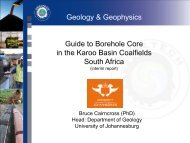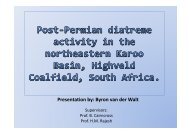coaltech upper olifants river catchment wetland inventory ...
coaltech upper olifants river catchment wetland inventory ...
coaltech upper olifants river catchment wetland inventory ...
You also want an ePaper? Increase the reach of your titles
YUMPU automatically turns print PDFs into web optimized ePapers that Google loves.
3.5.6 Livestock<br />
3.5.6.1 Water for livestock<br />
Wetlands can act as water sources for livestock on farms. Farmers usually use boreholes to<br />
provide water for their animals in different camps, but the presence of permanent <strong>wetland</strong>s in<br />
a camp makes the construction of a watering point in the camp unnecessary. The farmer<br />
can, therefore save money for each camp where a watering point does not need to be<br />
constructed (Palmer et al 2002, Kotze 2000, Kotze et al 2000).<br />
3.5.6.2 Grazing for livestock<br />
According to a literature review conducted in New Zealand on the effects of livestock grazing<br />
on <strong>wetland</strong>s, the impact of grazing on a <strong>wetland</strong> is site specific. Direct effects of grazing<br />
include trampling, the removal of biomass, nutrient inputs, bacterial contamination and the<br />
dispersal of seeds. The effect of the grazing on the biomass depends on the specific<br />
characteristics of the <strong>wetland</strong>, including the palatability of the plant species and how each of<br />
the species reacts to grazing. The ratio of increaser to decreaser species has a huge impact<br />
on the biomass in the <strong>wetland</strong> with and without grazing, as well as, the eventual species<br />
composition and dominant species in the <strong>wetland</strong>. It is, therefore necessary to have site<br />
specific research in order to determine the impact on a specific <strong>wetland</strong> (Reeves &<br />
Champion 2004). In a study conducted in the arid portions of the western United States it<br />
was determined that grazing by livestock was responsible for 80% of all damage sustained to<br />
riparian ecosystems (Hengle no date). It is, therefore important to assess the impact of<br />
grazing on <strong>wetland</strong> ecosystems in a certain area before allowing grazing to occur.<br />
Wetlands provide good grazing for livestock during the winter months in the UORC and are,<br />
therefore valuable for the provision of grazing during the end of the winter when the rest of<br />
the grazing areas do not have good grazing left. The <strong>wetland</strong>s do not have any particulate<br />
benefits for the rest of the year, since good quality grazing occurs over the entire grazing<br />
area. The most commonly grazed <strong>wetland</strong> types are the seepage <strong>wetland</strong>s. Some farmers<br />
within the UORC also seed the <strong>wetland</strong>s to encourage better grazing grasses to grow.<br />
Although seepage <strong>wetland</strong>s produce roughly twice the amount of grazing as normal veld, the<br />
seepage <strong>wetland</strong>s can normally not be utilised through summer as they are generally too wet<br />
for the livestock to move through it and can pose a threat of disease (Palmer et al 2002). The<br />
over-grazing of <strong>wetland</strong>s is an illegal activity in terms of the CARA.<br />
Wetland Database for UORC - 42 -




